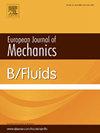弱强迫浅层流中的非对称垂直输运
IF 2.5
3区 工程技术
Q2 MECHANICS
引用次数: 0
摘要
在本文中,我们报告了通过数值模拟对浅层连续强制流内释放的示踪粒子的垂直传输进行的研究。这项研究的动机是在许多环境条件下遇到的浅层流动,并受到在电磁强迫浅层流体层中进行的实验室实验的启发。流动被限制在无应力顶壁和无滑动底壁的薄流体层中。研究了各种流动条件下浅层流的动力学和传输特性,这些流动条件的特征是与强迫有关的雷诺数 ReF 以及垂直和水平长度尺度的纵横比 δ。 强迫产生了一系列涡流,当 ReFδ2≳10 时,涡流变得不稳定。这些漩涡的核心部分伴随着上升气流,周围是较窄、较强的下沉气流。因此,在水平气流以涡度为主的地方会出现上升气流,而在水平气流以应变为主的地方则会出现下降气流。垂直流的强度和大小的不对称程度及其与水平结构的相关性取决于流动条件,并对流体体积内颗粒的垂直扩散产生重大影响。在导致较大不对称性的条件下,上升气流中的颗粒会缓慢向上移动,而下降气流中的颗粒则会迅速向下移动。此外,由于上升气流与涡度主导区域相关,颗粒在上升气流中的滞留时间比在下降气流中长。然而,当气流变得完全三维且高度不稳定(ReFδ2 值较大)时,这种传输不对称现象就会消失,因为在这种气流条件下,上升气流和下降气流表现出相似的强度和大小。因此,相似数量的颗粒会以相似的速度向上和向下输送。本文章由计算机程序翻译,如有差异,请以英文原文为准。
Asymmetric vertical transport in weakly forced shallow flows
In this paper, we report on an investigation of the vertical transport of tracer particles released within a shallow, continuously-forced flow by means of numerical simulations. The investigation is motivated by the shallow flows encountered in many environmental situations and inspired by the laboratory experiments conducted in electromagnetically forced shallow fluid layers. The flow is confined to a thin fluid layer by stress-free top and no-slip bottom walls. The dynamics and the transport properties of the shallow flow are investigated under various flow conditions characterized by a Reynolds number related to the forcing, , and the aspect ratio of vertical and horizontal length scales . The forcing generates an array of vortices that becomes unsteady when . These vortices are accompanied by upwellings in their cores which are surrounded by narrower, stronger downwellings. Hence, upwellings occur where the horizontal flow is vorticity-dominated, while downwellings where it is strain-dominated. The magnitude of the asymmetry in strength and size of the vertical flows and their correlation with horizontal structures depends on the flow conditions and significantly influences the vertical spreading of particles within the fluid volume. Under conditions leading to a large asymmetry, particles within updrafts are transported slowly upwards, while particles within downdrafts rapidly move downwards. In addition, particles are trapped for longer within the updrafts than downdrafts because of their correlation with vorticity-dominated regions. However, when the flow becomes fully three-dimensional and highly unsteady for large values, this transport asymmetry subsides because the updrafts and downdrafts exhibit similar strength and size in such flow conditions. Consequently, similar amounts of particles are transported upwards and downwards at similar rates.
求助全文
通过发布文献求助,成功后即可免费获取论文全文。
去求助
来源期刊
CiteScore
5.90
自引率
3.80%
发文量
127
审稿时长
58 days
期刊介绍:
The European Journal of Mechanics - B/Fluids publishes papers in all fields of fluid mechanics. Although investigations in well-established areas are within the scope of the journal, recent developments and innovative ideas are particularly welcome. Theoretical, computational and experimental papers are equally welcome. Mathematical methods, be they deterministic or stochastic, analytical or numerical, will be accepted provided they serve to clarify some identifiable problems in fluid mechanics, and provided the significance of results is explained. Similarly, experimental papers must add physical insight in to the understanding of fluid mechanics.

 求助内容:
求助内容: 应助结果提醒方式:
应助结果提醒方式:


